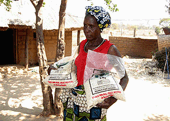Zambia: Achieving the MDGs, progress and challenges
Published on Wed, 2013-06-26 08:40
This report tracks the extent to which Zambia is making progress towards achieving the MDGs focuses on Goals 1 to 7 and assesses Zambia’s national development plans, the main tools for achieving economic and human development, particularly the Fifth National Development Plan (FNDP). It also analyses problems in the way the MDGs are formulated, arguing that unless these are taken care of, the human development conditions of countries such as Zambia will remain poor for a long time. Finally, it makes proposals for post 2015 reform. At the launch of the MDGs in 2000, Zambia’s human development indicators were weak, owing to the steady deterioration of the economic and social conditions since the mid-1970s, when prices of its main produce copper fell on the world market. From the late 1980s and 1990s Zambia implemented the World Bank and the International Monetary Fund inspired Structural Adjustment Programme (SAP), under which significant cuts to public expenditure were applied, considerably weakening delivery of social services in the health, education and other sectors. This period is also when the HIV and AIDS pandemic hit Zambia the hardest. After the deterioration in the 1990s, there has been a slight improvement in Zambia’s human development ranking: from 0.35 in 2000 to 0.395 in 2010, putting it at 150 out of 169 countries. Despite progress, human development is still low, and some of the goals will not be met. For the period 2006-2009 Zambia’s economy grew at an average of 6.1% per annum. Yet these gains have not been felt by the most vulnerable sections of society. Out of the 22 indicators reported on in the 2011 MDG progress report, only 6 (27%) are on track to being met, 12 (54%) need to be accelerated in order to be met and 4 (18%) will not be met. This suggests that the developments efforts are insufficient to meet the MDGs. Further, the fact that MDG 6 on HIV and AIDS is the only goal likely to be met suggests that global support, such as through the Global Fund on AIDS, Malaria and TB, is critical. Clearly, post 2015 development goals and targets must be less minimalist and quantitative. Human development also requires looking beyond economic growth to the nature and impact of that growth especially on the poor. Source: Social Watch Report 2013, National Report from Zambia |


